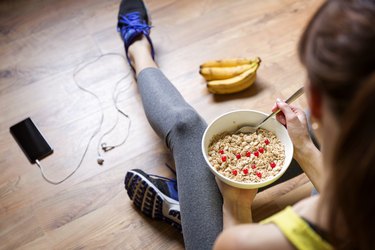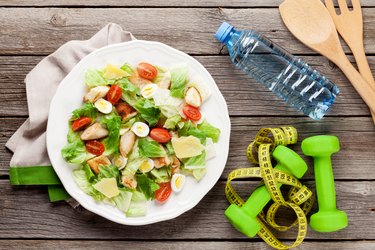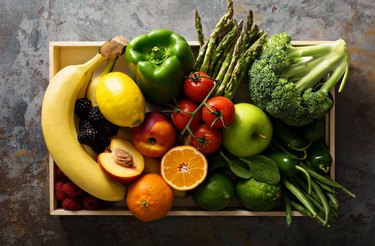
Weddings, reunions and vacations have a way of creeping up and catching us off guard. All of sudden, it's a mad rush to get the dress or the bikini — and then fit into it!
It's a lot to accomplish in a little time, but don't freak out. You've got 30 days. You've got this.
Video of the Day
Video of the Day
You're going to have to make some big changes over the next 30 days if you want to noticeably trim and tone your legs. Make a clean diet, a lot of cardio and some strength training your priority, and you'll be happy with your results a month from now.
Understand How Weight Loss Works
Let's clarify something right off the bat: you can't spot-reduce. You can't lose weight in just your legs, without losing weight all over your body. As you reduce your body fat by managing your calorie balance, you'll lose some weight in your face, arms, belly, butt and legs.
The other factor to keep in mind is that your body type determines how you lose fat. If you tend to store fat in your lower body, usually that tends to be the most stubborn fat. You might notice fat loss in other areas of your body first. But stick with it because you will eventually lose fat in the legs, even if it takes time.

Cut Calories
Diet plays the starring role in weight loss. Weight gain is largely the result of a caloric imbalance. When you take in more calories than your body needs for energy production, those calories are stored as fat.
Your calorie needs depend on several factors, including your age, weight, gender and activity level. It's very specific to you as an individual, and your doctor or a nutritionist is the best person to help you determine your sweet spot, calorie-wise.
A rough estimate that's been bandied about in the health field is that cutting 3,500 calories from your daily diet will equal 1 pound of fat loss. While this is probably a reliable estimate in the short-term, according to Today's Dietitian, it doesn't hold up over time. But for the next 30 days, you can use it as a rough guide for managing your calorie intake.
According the aforementioned estimate, if you cut 500 to 1,000 calories from your diet weekly, you'll lose 1 to 2 pounds per week. This means reducing 70 to 140 calories a day — totally manageable.
Combine this with the increase in exercise you're about to implement, and you'll see some significant fat loss over the next month.

Eat Clean
Managing your calories is not nearly as challenging when you eat a clean diet. A clean diet, also sometimes referred to a whole foods diet, is one that is based around eating foods in as close to their natural state as possible.
So what can you eat? Lots. Make the focus of your diet fresh fruits and vegetables — salads, sauteed spinach, steamed broccoli.
Clean protein — such as white meat chicken, fish, tofu and beans — will help you feel satisfied at meals and give your body the raw materials for building muscle, which will increase your metabolism (more on that later).
Whole grains, like brown and black rice and quinoa, are healthy additions to your meals, rich in fiber to keep you full and long-lasting carbohydrates to give you energy for your workouts. These should take the place of any refined carbohydrates — breads, pastas, white rice — you might be used to eating.
Avoid sauces and cheese toppings and use a minimal amount of healthy oils, like olive oil, for cooking. Make use of herbs and spices to add flavor.
Although an occasional sweet treat is OK, commit to cutting out any other foods that don't live up to clean standards.
Do High-Intensity Cardio
Exercise is the other part of the fat-loss equation, and cardio is going to make the biggest difference in the short-term. In the next 30 days, plan to fit in a cardio workout most days of the week. Put it on your calendar, and make it a priority.
Any type of cardio is better than none, but you've got a goal to reach. The harder you workout, the more calories and fat you'll burn. So aim to increase the intensity of your cardio sessions; go into each session with the goal of working as hard as you can for whatever amount of time you have.
A little more intensity can make a lot of difference. For example, if you you walk at an easy pace of 3.5 miles per hour for 30 minutes, you'll burn between 120 and 175 calories, depending on your weight. However, if you run at a pace of 5.2 miles per hour, you'll burn more than double the calories — 270 to 400.
High-intensity interval training is another highly effective method of cardio training. In this training method, you alternate periods of vigorous activity, like sprinting, with periods of recovery, like walking or jogging. This type of training has been shown to be more effective than slower steady-state workouts for burning total body fat. If you're not up to a full high-intensity workout, interval training can be just as effective.
Read more: How to Do HIIT Treadmill Workouts
Strength Train
Your last assignment for the next month: build muscle. The more muscle you have, the more efficient your body is at processing the calories you take in. Total-body strength training will help you burn more than with cardio and diet alone.
Doing strength training exercises for your legs will not only help you burn more fat faster, but it will make your legs look sleek and toned once the fat comes off. But you shouldn't just train your legs — you want to build total-body lean muscle mass for the biggest metabolic boost and all-over muscle tone.
Twice a week, train all your major muscle groups — arms, chest, shoulders, back, abs, glutes, thighs and calves. Compound exercises like pull-ups, push-ups, rows, squats, lunges and step ups are efficient and effective, and will get you great results without having to spend a lot of time in the gym.
The Bottom Line
Follow this plan for the next 30 days, and you will see changes in your lower body. But keep your expectations realistic. Judge your progress by how you feel and how your clothes fit, rather than a number on the scale.
Most importantly, after the 30 days are up keep going. The best weight loss results happen gradually over time. Quick fixes and fads rarely result in lasting fat loss. Make a clean diet and regular exercise part of your lifestyle and you'll be ready well in advance of your next big event or vacation.
Read more: The DOs and DON'Ts of Clean Eating